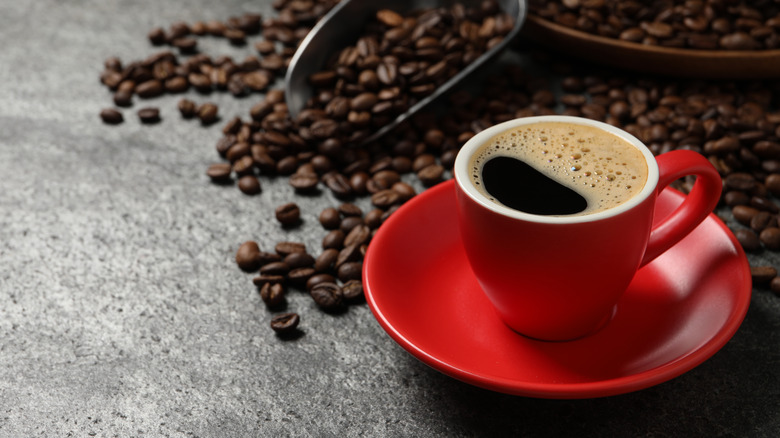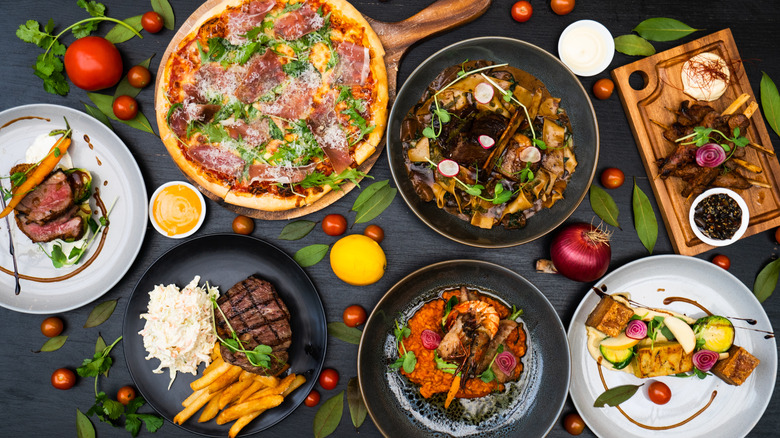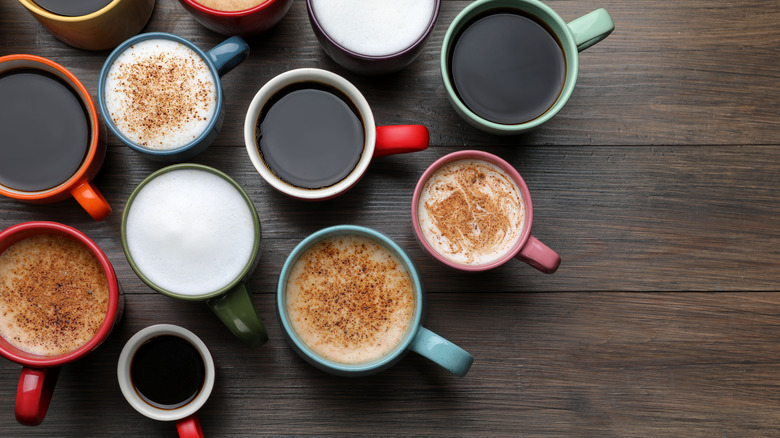Your Mug's Color Could Be Affecting How Your Coffee Tastes
If consuming your favorite hot beverage is an integral part of your morning routine, chances are, you have a "ritual" that surrounds it. A favorite cup, a particular book, publication, or soundtrack for company, a fixed spot where you like to imbibe the first gloriously steaming sips. Apart from the positive effects of starting your day with the comforting familiarity of such a ritual, the fact is that enjoying food and drink is a multisensory experience, and this holds true for your morning cup of joe.
It may not be possible to influence all the myriad factors that affect your coffee experience, but one thing you can easily control is the color of your coffee mug, and it could make more of a difference than you'd expect. Simply changing its color can make your coffee taste bolder or sweeter, and sometimes even more complex. Research has shown a red container can make the drink it holds seem sweeter, while a more specific study from 2015 published in the journal Flavour hinted at how a white cup could make your coffee taste more intense or bitter.
So, how deeply is your coffee cup's color affecting your beloved caffeine ritual? Understanding the underlying link between colors and taste is a good place to start looking for answers to this question.
Making sense of taste
It's no secret that how much you enjoy a meal is influenced by much more than just culinary factors. Restaurants looking to give diners a memorable experience will not just try and churn out the tastiest fare; they will also carefully select the color and shape of the glasses and plates, the lighting and decor of the establishment, background music, and much more.
In particular, there are deeply ingrained associations between flavors and colors. A 2019 study published in the journal Experimental Psychology found that colors like pink and red are most strongly associated with sweetness, while yellow and green suggest sourness, and brown, black, and purple imply bitterness. Blue has been the topic of much discussion over whether it allures or repels consumers. This is because the color is rarely found in nature and is, therefore, not part of our ingrained edible food color palate. However, brightly colored blue-raspberry-flavored foods — which aren't made from raspberry flavors at all — are surprisingly popular.
You can easily incorporate these color-flavor interactions by using different colored plates and glasses with any dish or beverage you wish. Simply being mindful of the color of a dish and how it contrasts with the dishware it is served on can go a long way in enhancing the overall experience of consuming it. Consider how a sprightly green salad could be enhanced by a yellow serving bowl or, conversely, how a bolognese sauce might be lost when served on a red plate. The potential combinations to try out are virtually limitless and can even help make relatively mundane dishes more appetizing.
What's the right color for your coffee cup?
So what's all that mean for your morning cup of joe? After all, you'll be holding that mug (whatever color it might be) every time you take a sip, so the color of your cup and how it contrasts with your coffee are worth keeping in mind. To start, a white cup could make your beverage feel more intense or bitter because it makes the color of your coffee appear darker. One of the reasons espresso bars in Italy often use small white cups is so that the caramel-colored crema — the foam on top of the espresso that gives the drink its thick texture and ashy bitter "kick" — can be properly seen against the cup's light backdrop.
You can also think about the associations are minds create between certain colors and specific flavors or smells. If you enjoy dark coffee, try choosing a color associated with bitterness, like brown or black. A purple cup — the eggplant hue has long been connected with royalty and wealth — can also give your beverage a distinctive and luxurious feel. Other interesting cup colors to try out are green and yellow. Professional taster and author of "How to Taste" Mandy Naglich told Food & Wine that these colors are connected with sourness; as such, they could help bring complex acidic notes of the coffee into focus.
Of course, choosing the color of your coffee cup isn't an exact science, and personal preferences and individual associations play a role, so keep a few color options handy and see which one fits your caffeine ritual best.


